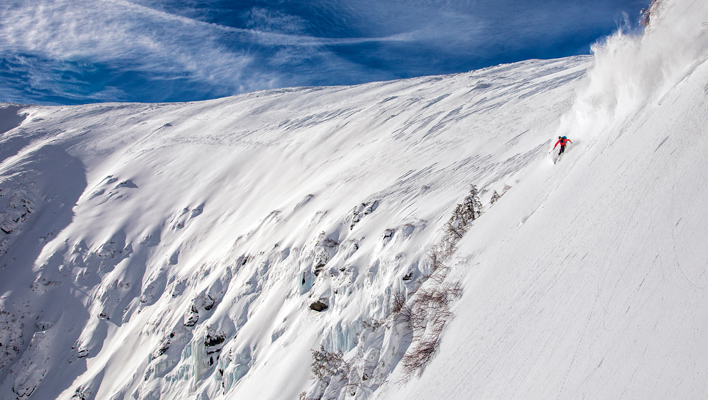In spite of the prominence of New Hampshire’s Tuckerman Ravine as a classic spring-skiing destination, the U.S. Forest Service has closed access to Mt. Washington’s east side and the Mt. Washington Avalanche Center has ceased forecasting for the season, instead urging visitors to stay off Mt. Washington in accordance with New Hampshire’s Stay at Home order that’s part of the state’s response to the COVID-19 pandemic. While it’s not quite the same as a spring day spent in Tucks, Backcountry’s Boundless Issue (#133) features a 24-page deep dive into the history of skiing on Mt. Washington—purchase a copy of the issue now at shop.holpublications.com with free shipping or download the digital version for just $3.50.
Here’s an essay that’s excerpted from the feature.
It was 5 p.m., and the sun was starting to set on the snowfields above Tuckerman Ravine. They say nothing good happens after 3 p.m., up there as the shade line creeps across the bowl, but that day was different. I’d just ticked off every bucket-list run in Tucks and was capping off the day with my partner Hilary, who’d come up to meet me just in time for my ninth run. It was a classic spring day that every New England backcountry skier seeks, and little did I know that it would set me on the path to discovering what New Hampshire’s Presidential Range really has to offer.

There’s no question why Tuckerman Ravine is the epicenter of New England backcountry. Its fetch builds a 50-foot base over the course of the winter, catching snow from all angles as the prevailing northwest winds constantly load snow in the massive, 1,000-foot basin. There are so many reasons to love this zone, but as I worked through all the runs that day, I knew there was more incredible skiing to be found in the Presidentials.
A few weeks later, Hilary and I ventured into the northern Presidentials and confirmed that there’s so much more than just the low-hanging fruits of the Pinkham “Front Range.” We made our way up to Crag Camp, a shelter that hangs on the western edge of King Ravine, a zone with a reputation for unpredictable lines riddled with closeout ice bulges. It was there where my perspective shifted; no longer were we in familiar territory, and the little beta that did exist helped the area feel new and refreshing.
The climb up from Randolph had taken us longer than expected, and with heavy packs and transitioning seasons we struggled up the direct approach along a hiking trail. The late-setting May sun played in our favor and after arriving at the shelter we were set on getting a few turns in before calling it a day. The first line we saw was one that closed out, but it was worth every turn, with views that stretched far northward into the valley below. While this was hardly all that King Ravine had to offer, it was important to get familiar with this striking zone.
The next morning we awoke to clear weather and knew that we had an opportunity to push south and spend the entire day in the high alpine. We gained the ridgeline at Thunderstorm Junction, from where we had our first views of Mt. Washington, 3.5 miles away with innumerable chutes, gullies and snowfields separating us. There’s something special about being above tree line in the Whites, especially on the rare days where the wind lays down and the skies extend clear into Vermont. We dropped into Jefferson Ravine and were stripping layers on the 1,200-foot bootpack out. This was what skiing in the northern Presidentials was all about: remote lines with no one around but the occasional hiker we passed while linking back up with the Gulfside Trail.
The last objective of the day was a line over in the Great Gulf. It took a while to cover this stretch, with skis on our packs and miles of rockhopping. The sun was setting, it was well after 3 p.m., and we had already been touring for more than eight hours—fatigue and hunger were starting to set in. By the time we made it over to the line, we were questioning our ability to hike back out and settled on just skiing the line’s upper half.
I though the steep entrance would make for a great photo, so Hilary hung back with the camera while I made my way over to the drop. More focused on making a great turn than investigating the snowpack, I tunneled the tip of one of my skis beneath a rotten section of snow, and the next thing I knew I was a couple hundred feet down the line, struggling to self-arrest. Somehow I managed to dig my feet in and paused to take inventory on the situation.
I was uninjured, but my right ski had snapped in half, and our tour was officially done. It was a five-mile hike back to Crag Camp, and with all that had gone right and horribly wrong on this tour, I knew there was so much more to learn and explore in the far reaches of the White Mountains.
—
Andrew Drummond is a life-long skier based out of the White Mountains who owns and operates the backcountry ski shop Ski The Whites in Jackson, N.H. This essay first appeared in Backcountry’s Boundless Issue (#133).










Related posts:
History on the Headwall: Mt. Washington’s Tuckerman Ravine
Inside New Hampshire’s Craft Glading Movement
Meeting the Masses on New Hampshire’s Mt. Washington